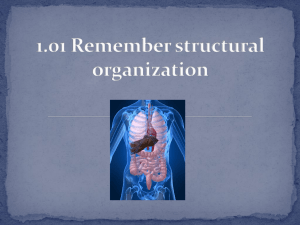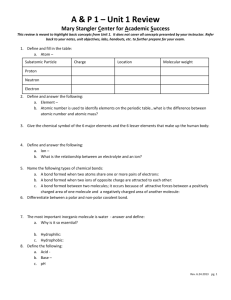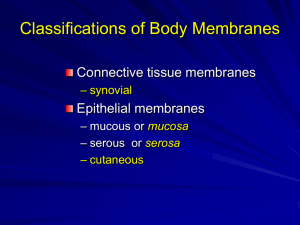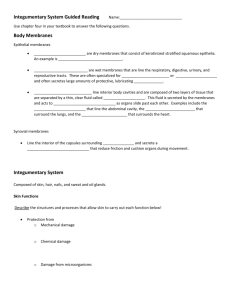the skin
advertisement
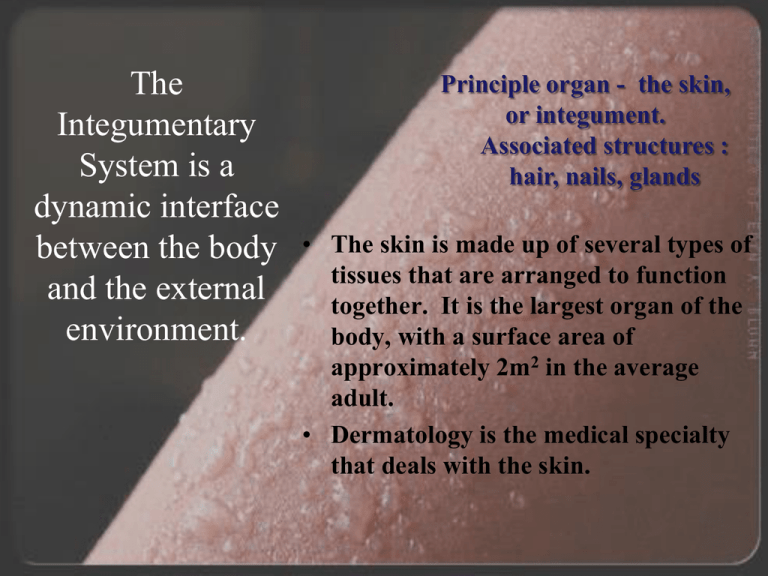
The Integumentary System is a dynamic interface between the body and the external environment. Principle organ - the skin, or integument. Associated structures : hair, nails, glands • The skin is made up of several types of tissues that are arranged to function together. It is the largest organ of the body, with a surface area of approximately 2m2 in the average adult. • Dermatology is the medical specialty that deals with the skin. INTEGUMENT • Body membranes - thin sheets of tissue that cover the body, line body cavities and cover organs within the cavities in hollow organs. Membranes also line internal spaces of the body that open to the outside of the body. They can be categorized as epithelial or connective tissue membrane. • There are three types of epithelial membranes: 1. The Cutaneous membrane 2. The Serous membranes 3. The Mucous membranes There are two types of connective tissue membranes: 1. The Synovial membrane 2. The Meningeal membranes EPITHELIAL MEMBRANES – Contain epithelial tissue and the underlying connective tissues. • Epithelial tissues include: squamous, cuboidal, columnar, and transitional cells with a simple or stratified arrangement • 3 Main Types of Epithelial Membranes 1. Cutaneous Membrane-the skin 2. Serous Membrane-lines body cavities and covers organs 3. Mucous Membrane-lines the internal spaces that open to the outside of the body Cutaneous membrane ( the skin) is discussed in depth later Serous Membrane Structure: consist of consists of a single layer of simple squamous cells which produce the lubricating serous fluid and the connective tissue to which it is attached – Connective layer- Basement membrane that holds and supports the epithelial cellsprovides the blood vessels and nerves for the secretory epithelial cells, and serves as the binding layer which allows the whole serous membrane to adhere to organs and other structures. Serous Membrane • Line body cavities that do not open directly to the outside and cover the organs located in those cavities. • Serosa is covered by a thin layer of serous fluid that is secreted by the epithelial cells. – Serous fluid lubricates the membrane and reduces friction and abrasion when organs in the thoracic or abdominopelvic cavity move against each other or the cavity wall. • Serous membranes have special names given according to their location. For example, the serous membrane that lines the thoracic cavity and covers the lungs is called pleura. Three main serous cavities within the human body. • Pericardium found within the thorax and provides a lining around the heart. Pleural cavity -The pleura are made up of two cavities that line the lungs. contains the lungs. The peritoneum lines the abdominal region and provides a cover for the stomach, liver and intestines Each serous membrane is made up of two distinct layers - the parietal layer and the visceral layer. •Parietal Layer - the outer layer of the membrane that is attached to surrounding tissues in the cavity. •Lines the walls of a body cavity. •Visceral Layer - the inner layer that covers the organs. The two layers are separated by a thin layer of fluid, called serous fluid, which acts as a lubricant and reduces friction between organs and other organs or tissues. Inflammation of the pleurathe serous membrane lining of the pleural cavity. Inflammation of the peritoniumthe serous membrane which lines part of the abdominal cavity. Inflammation of the pericardium- the membrane lining of part of the thoracic cavity and covers the heart Mucus Membrane Line the body cavities that open to the outside, including . Consist of a mucus-forming epithelium that is attached to an underlying connective tissue. The epithelial layer(s) vary in structure depending on the location. The moisture found in a mucous membrane acts to protect the body by creating a barrier which can trap pathogens, dirt, and particulate matter so that they can be trapped and eliminated by the body. Mucus can also act as a lubricant, and it facilitates gas exchange and absorption in the lungs. The absorption qualities of mucous membranes are important in the digestive tract, where the body pulls necessary nutrients out of food. Many toxins and other harmful substances can be quickly absorbed through the mucosa. Connective Tissue Membranes The Synovial membrane • Connective tissue membranes that line the cavities of the freely movable joints such as the shoulder, elbow, and knee. • Secrete synovial fluid into the joint cavity, which lubricates the cartilage on the ends of the bones so that they can move freely and without friction. The Meningeal membranes • The meninges are three connective tissue membranes that lie just external to the brain and spinal cord. From external to internal, the meningeal layers are the Dura mater, the Arachnoid and the Pia mater. More on this later. The Cutaneous Membrane—the Skin – Cutaneous membrane • Epidermis – epithelial tissue • Dermis – connective tissue – Accessory Structures • Glands • Hair (hair follicles) • Nails – Subcutaneous Deep to skin – not part of skin: the hypodermis • The Epidermis -Keratinized, stratified squamous epithelium -Contains no blood vessels -4 types of cells Has 4-5 distinct strata (layers) of cells Thick vs. thin skin • The epidermal layers move up the strata changing shape and composition as they differentiate and become filled with keratin, a tough fiberous structural protein. • The outermost layer of the epidermis made up of dead cells that contain keratin. The thickness of the stratum corneum varies according to the amount of protection and/or grip required by a region of the body. • Stratum lucidum- found only in areas of thick skin, ie. palms of the hands and soles of the feet. • Stratum granulosum- (or granular layer) have lost their nuclei and are dying. Keratin proteins and water-proofing lipids are being produced and organized in this layer. • Stratum Spinosum – these cells start to synthesize keratin and change from being columnar to polygonal. • Stratum germinativum (or stratum basale) -the deepest layer where cell division occurs. This layer regenerates the layers of the epidermis. The Dermis • The dermis varies in thickness depending on the location of the skin, but is thicker than the epidermis • It is composed of three types of tissue: • collagen • elastic tissue fibers • reticular fibers. The two layers of the dermis are the papillary and reticular layers. Papillary Dermis • the uppermost layer of the dermis. • Composed of fine and loosely arranged collagen fibers. – Collagen is the main component of connective tissue, and is the most abundant protein in mammals Make fingerprints and footprints Improves grip • It is named for its fingerlike projections called papillae, which extend toward the epidermis. The papillae provide the dermis with a "bumpy" surface that protrudes into the epidermis, strengthening the connection between the two layers of skin. Collagen and elastin fibers in Scanning electron microscopy Dermal papilla in scanning electron microscopy Reticular Dermis • The lower layer of the dermis. • Composed of thick, densely packed collagen fibers, and dermal elastic fibers. – elastic fibers are bundles of elastin proteins found in the extracellular of connective tissue. These fibers die with age. This layer is important in giving the skin strength and elasticity, as well as housing other important epithelial derived structures such as glands and hair follicles. Cross section of the dermis HYPODERMIS (or SUBCUTANEOUS layer) • Under the dermis- composed of loose connective tissue and adipose tissue. • Function: – insulation (helps to regulate temperature) – shock absorbers (help protect underlying layers) – stores lipids . • The hypodermis also contains larger blood vessels • The hypodermis is 810% thicker in females than in males due to the greater number of adipocytes and is likely hormonally influenced. Ovulation may be disturbed in women with low fat reserves and the softening of the body contours in females plays a part in sexual attraction. Link hypodermis
